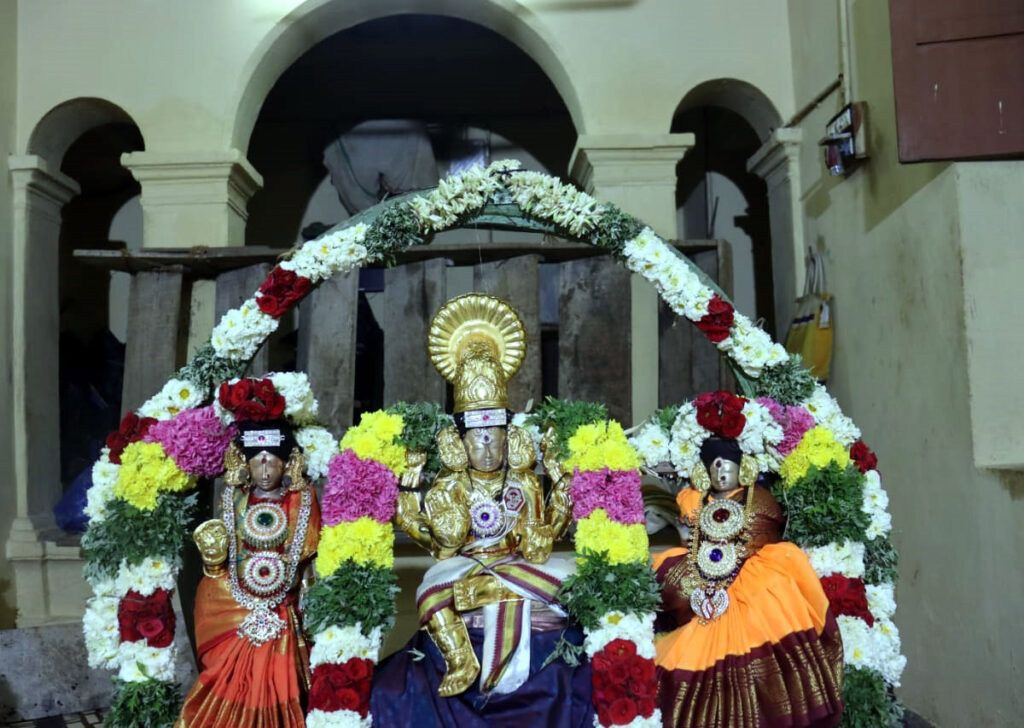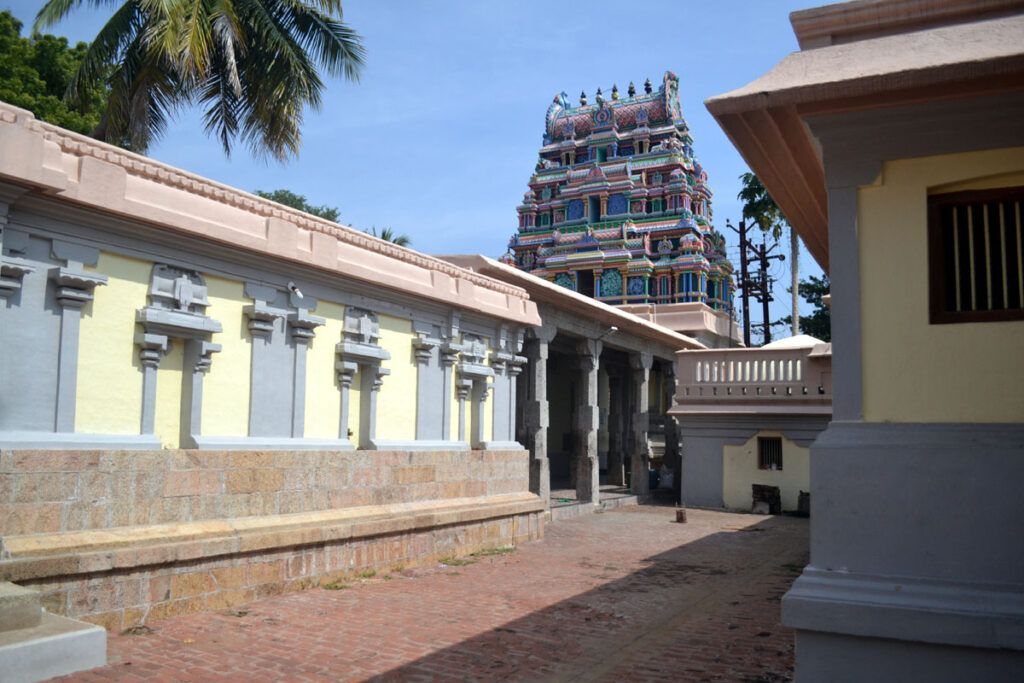Gauthameswarar Temple Kumbakonam
Gauthameswarar Temple is a Hindu temple dedicated to Shiva, located at Kumbakonam in Thanjavur district of Tamil Nadu, India. The temple is located on the eastern bank of the Mahamaham tank, Kumbakonam.

Contents
- 1 History of Gauthameswarar Temple:
- 2 Legend of Gauthameswarar Temple:
- 3 Significance of Gauthameswarar Temple:
- 4 Gauthameswarar Temple Timing and Pooja:
- 5 Specialty of Gauthameswarar Temple kumbakonam:
- 6 Places to visit near Gauthameswarar Temple:
- 7 FAQ:
- 8 How to reach Gauthameswarar Temple:
- 9 Google Maps:
History of Gauthameswarar Temple:
The temple’s history is shrouded in legend, but it is believed to have been built around the 7th century CE. The temple’s name is derived from the sage Gautama, who is said to have worshipped Shiva here to atone for the sin of killing a cow.
The temple is a Chola-style structure, with a large gopuram (tower) at the entrance. The temple complex also includes shrines to Goddess Parvati, Lord Vinayaka, and Lord Murugan.
The Gauthameswarar Temple is a popular pilgrimage destination for Hindus, and is particularly busy during the Mahamaham festival. The temple is also a popular tourist destination, and is known for its beautiful architecture and sculptures.
Here is a brief timeline of the temple’s history:
- 7th century CE: The temple is believed to have been built around this time.
- 11th century CE: The temple is renovated and expanded by the Chola kings.
- 17th century CE: The temple is damaged during the Nayak wars.
- 18th century CE: The temple is restored by the Maratha rulers.
- 19th century CE: The temple is taken over by the British East India Company.
- 20th century CE: The temple is returned to Hindu control after India’s independence.
Read More>> Nageshwar Jyotirlinga Dwaraka: 7th CE Temple with Divine Powers
Legend of Gauthameswarar Temple:
According to the legend, Gautama was once performing austerities in the vicinity of the temple site, seeking Lord Shiva’s blessings. During one of his meditation sessions, a thread from the sacred pot (kumba) he was using to gather water fell to the ground, and miraculously transformed into a Shiva linga. This divine manifestation marked the establishment of the Gauthameswarar Temple.
Over time, the temple complex grew in importance, attracting pilgrims and devotees from across the region. Its architecture reflects the architectural styles of the Chola and Pandya dynasties, with intricate carvings and sculptures adorning the walls and pillars.
The temple’s presiding deity, Gauthameswarar, is revered as the remover of obstacles and the bestower of wisdom. His consort, Soundara Nayaki, embodies grace and beauty. The temple is renowned for its annual Mahamaham festival, a grand celebration of spirituality and devotion.
The legend of Gautama and the sacred thread underscores the temple’s sacred origins and its enduring connection to Lord Shiva. The Gauthameswarar Temple continues to hold a special place in the hearts of devotees, offering solace, spiritual solace, and guidance to those who seek its blessings.
Read More>> Shree Somnath Jyotirling Temple: The Shrine of Eternal Light

Significance of Gauthameswarar Temple:
Mythological Significance
According to Hindu legends, the temple’s origin is linked to the sage Gautama. While performing severe penance, a thread from his kumba (pot) fell to the ground, marking the spot where the Shiva lingam emerged. The Lingam was named Gauthameswarar, meaning “Shiva of Gautama.”
Spiritual Significance
The temple is revered for its power to bestow blessings and remove obstacles. Devotees believe that Lord Gauthameswarar, accompanied by his consort Soundara Nayaki, grants moksha (liberation) and fulfills their wishes. The temple is particularly revered for healing ailments and removing spiritual impurities.
Architectural Significance
The temple’s architectural style showcases the brilliance of ancient Tamil Nadu craftsmanship. The vimana, the tower over the sanctum sanctorum, is built in Dravidian style and stands majestically. The intricate carvings and sculptures adorning the temple walls and pillars depict various Hindu deities and scenes from mythology.
Cultural Significance
The temple is deeply embedded in the cultural fabric of Kumbakonam. It is a major venue for religious festivals and events, such as the annual Ratha Yatra procession and the Mahamaham festival. The temple’s art and architecture have inspired local traditions and practices, including music, dance, and storytelling.
Overall Significance
Gauthameswarar Temple stands as a testament to the spiritual, architectural, and cultural heritage of India. It is a sacred pilgrimage destination for millions of devotees, a marvel of ancient architecture, and a repository of rich cultural traditions. The temple’s significance transcends the physical structure, embodying the enduring power of faith and devotion.
Read More>> Trimbakeshwar Jyotirlinga Temple
Gauthameswarar Temple Timing and Pooja:
The temple is open to the public from 6:00 AM to 12:00 PM and from 4:00 PM to 9:00 PM.
The daily pooja schedule at Gauthameswarar Temple is as follows:
Morning
- 6:00 AM – Mangala Aarti
- 6:30 AM – Kalasabhishekam
- 7:00 AM – Suprabhatham
- 7:30 AM – Usha Kala pooja
Evening
- 4:00 PM – Sandhya Kala pooja
- 5:00 PM – Deeparadhana
- 6:00 PM – Aarti
- 7:00 PM – Sayaratnam
In addition to the daily pooja schedule, there are also special poojas that are conducted on special occasions. These poojas include:
- Maha Shivaratri
- Karthikai Deepam
- Navaratri
- Shivratri
Read More>> Kamakhya Temple: The Tantric Temple of Mystery and Magic

Specialty of Gauthameswarar Temple kumbakonam:
- The temple is said to have been built by the sage Gowthama Muni, who worshipped here to get rid of the sin of killing a cow. It is believed that the thread around the kumba (pot) fell in this place and the linga was formed.
- The presiding deity of the temple is Gauthameswarar, a manifestation of Lord Shiva. His consort, Parvati, is known as Soundara Nayaki.
- The temple has a unique architecture with five gopurams (towers), including a Rajagopuram (tallest tower) that is 120 feet high.
- The temple is also known for its exquisite sculptures and carvings, which depict various Hindu mythological stories.
- The temple is a popular pilgrimage destination for Hindus from all over India.
Other notable features of the temple
- The temple has a sacred pond called Gowthama Theertham, which is believed to have healing powers.
- The temple is home to a number of festivals, including the Mahamaham festival, which is one of the largest religious gatherings in India.
- The temple is also a center for learning and spiritual education.
Read More>> Mahamaya Shakti Peeth Amarnath
Places to visit near Gauthameswarar Temple:
Sarangapani Temple: This is one of the major temples in Kumbakonam dedicated to Lord Vishnu. It’s one of the Divya Desams, the 108 temples of Vishnu revered in Nalayira Divya Prabandham.
Mahamaham Tank: This is a sacred tank located in the heart of Kumbakonam. The Mahamaham festival, which takes place here once in 12 years, is a major event that attracts pilgrims from all over.
Adi Kumbeswarar Temple: Another significant temple in Kumbakonam, dedicated to Lord Shiva. It’s believed to be one of the oldest temples in the town.
Chakrapani Temple: This temple is dedicated to Lord Vishnu and is famous for its architectural beauty and the deity’s unique posture holding a Sudarshana Chakra.
Sarangapani Kovil Street: Take a stroll down this street to experience the vibrant atmosphere and explore various shops selling religious items, traditional artifacts, and local handicrafts.
Navagraha Temples: Kumbakonam is known for its Navagraha temples, each dedicated to one of the nine celestial bodies in Hindu astrology. These temples are scattered around the town and are worth a visit.
Darasuram Airavatesvara Temple: A UNESCO World Heritage Site, this temple is a marvel of Chola architecture. It’s located a bit outside Kumbakonam but is well worth the visit.
Kumbakonam Arts and Crafts: Explore local markets to discover traditional art and craft items such as bronze idols, silk sarees, and Tanjore paintings.
FAQ:
When was Gauthameswarar Temple built?
The temple is believed to have been built by the Chola dynasty in the 10th century CE. However, there is evidence to suggest that the temple may have been built earlier, possibly by the Pallava dynasty.
Who is Gauthameswarar?
Gautameshwarar is a form of Lord Shiva. The name “Gautameshwarar” means “the lord of Gautama.” Gautama is a sage who is said to have worshipped Lord Shiva at this temple.
What are the main features of the temple?
The temple is a large and complex structure. It has a five-tiered gopuram, or tower, at the entrance. The temple also has a number of shrines dedicated to other deities, including Vishnu, Parvati, and Ganesha.
What are the festivals celebrated at the temple?
The temple celebrates a number of festivals throughout the year. The most important festival is the Maha Shivaratri festival, which is celebrated in February or March. Other festivals include the Karthigai Deepam festival, which is celebrated in November or December, and the Aadi Pooram festival, which is celebrated in July or August.
How can I get to Gauthameswarar Temple?
The temple is located in the town of Kumbakonam. It is well-connected by road and rail. The nearest airport is the Tiruchirapalli International Airport, which is about 100 kilometers away.
Here are some tips for visiting Gauthameswarar Temple:
- The temple is open from 6:00 am to 12:00 pm and 4:00 pm to 8:00 pm.
- It is advisable to wear loose, comfortable clothing.
- Women should cover their heads before entering the temple.
- It is customary to remove shoes before entering the temple.
- Photography is allowed in the temple, but it is advisable to ask permission before taking pictures of the deities.
How to reach Gauthameswarar Temple:
By Air:
The nearest airport is the Trichy International Airport (IATA: TRZ), which is approximately 91 kilometers away from Kumbakonam. From the airport, you can hire a taxi or use other modes of transportation to reach Kumbakonam.
By Train:
Kumbakonam has its own railway station, Kumbakonam Railway Station (station code: KMU), which is well-connected to major cities in Tamil Nadu and other parts of India. You can take a train to Kumbakonam Railway Station and then hire a taxi or use local transportation to reach the Gauthameswarar Temple.
By Road:
Kumbakonam is well-connected by roads, and you can reach the town by bus or private vehicle. The town is well-linked with nearby cities and towns through a network of state and national highways.
Local Transportation in Kumbakonam:
Once you reach Kumbakonam, you can use local transportation options like auto-rickshaws, cycle rickshaws, and taxis to reach the Gauthameswarar Temple, which is likely to be a well-known landmark in the town. You can ask locals for directions, and they will be able to guide you to the temple.
